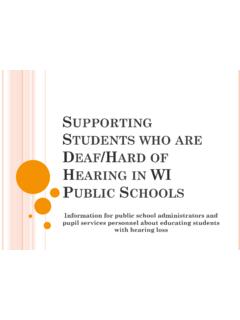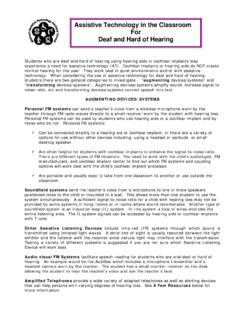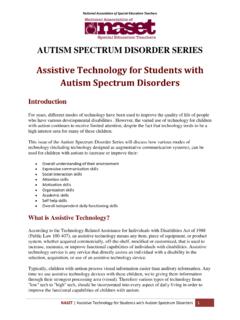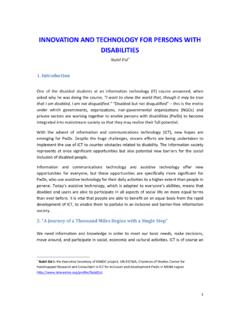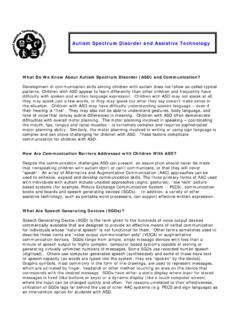Transcription of The Use of Technology to Enhance The Learning ... - ed
1 Technology ENHANCES ESL STUDENTS' Learning EXPERIENCE The Use of Technology to Enhance The Learning Experience of ESL Students. Abdoulaye Diallo Concordia University - Portland A Thesis Presented to The Graduate Program in Partial Fulfillment of the Requirements For the Degree of Masters of Education in TESOL Concordia University 2014 2 Technology ENHANCES ESL STUDENTS' Learning EXPERIENCE Abstract The growing numbers of ELLs (English language learners) makes the search for new effective and efficient instructional methods a priority. While several teaching methods and tools are used to help ELLs succeed in becoming proficient English speakers, Technology has gained substantial attention due to the abundance of new Technology tools, which are helping us, achieve more in less time and also due to our increasingly connected world. Tablets and apps are changing the nature of English language instruction. The purpose of this study is to investigate how Technology tools helped ELLs become more proficient in English.
2 Studies reviews and summaries of research published on the topic of Technology tools and English language acquisition, specially focusing on the efficiency and effectiveness of Technology tools in helping ELLs acquire English language will be scrutinized. Theories of second language acquisition will be used to better understand how Krashen s (1982) comprehensive input theory delivered using new Technology provides learners with comprehensible materials leading to acquiring faster the language. Overall, from the current review of literature, I conclude that Technology is an effective and efficient tool in helping ELLs become proficient in English. While there are several benefits, of using Technology to Enhance ELLs Learning skills, quantitative data from various studies shows that factors such as costs and trainings are of great importance in assessing how efficient Technology tools are. Thus, I will also explore relevant challenges to using Technology for English language instruction.
3 3 Technology ENHANCES ESL STUDENTS' Learning EXPERIENCE TABLE OF CONTENTS CHAPTER 1 - THE PROBLEM .. 4 CHAPTER 2 - THE DEVELOPMENT OF THE PROBLEM IN PUBLISHED LITERATURE .. 8 CHAPTER 3 - LITERATURE REVIEW .. 13 SECOND LANGUAGE ACQUISITION THEORIES TRADITIONAL METHODS VS Technology BASED METHODS DIFFERENTIATED INSTRUCTION LIMITS OF Technology Technology AS A TOOL ENHANCING ENGLISH Learning CHAPTER 4 - SUMMARY, CONCLUSIONS, & RECOMMENDATIONS .. 35 REFERENCES .. 38 4 Technology ENHANCES ESL STUDENTS' Learning EXPERIENCE Chapter One The problem In our increasingly diversified and interconnected world, the English language has become the leading communication vehicle (Tsedal, 2012), allowing people from different parts of the world to conduct business without having to use multiple languages and therefore avoiding the complex and bureaucratic process of multiple language translation. In addition to the necessity of conducting business in a single language, immigration on a local level also contributes to the need to rethink the way the English language is taught to speakers of other languages.
4 In the United States, the shift in demography due to immigration and population growth makes finding efficient ways of teaching English to English language learners (ELLs) a high priority. For example, according to Echevarr a, Vogt, and Short (2013), the years 1998-99 to 2008-09 saw an increase of 51% in the ELLs population in the pre-k-12 enrollment nationwide. While there are different ways of helping ELLs become proficient in English, Technology is of critical importance in this area because of the growing interest both from the public and schools institutions across the country and because of the possibilities it offers compared to traditional teaching method implemented for years in classrooms (Gottlieb, 2006). We are living in a world of advanced Technology and most learners are exposed to these new technologies at a young age. The use of technologies will not only allow learners to quickly master new language skills through exposure to a variety of new technologies, but also, the excitement that comes with these new medium can motivate learners for an extended period of time.
5 While Technology , when properly applied can be engaging and produce fast Learning results, as outlined in the study conducted by Xiao and Jones(1995), one must 5 Technology ENHANCES ESL STUDENTS' Learning EXPERIENCE realize that new Technology tools are not as perfect as they are portrayed to be . Winkle and Goertler (2008) study point to limits of Technology tools such as ownership and accessibility, students level of ability to perform computer-based tasks, and finally students personal and academic use of multimedia tools. Analyzing these shortcomings will inform this study. The purpose of this study is to discover how Technology can help ELLs become more fluent in English. The terms ELLs (English language learners) and ESL (English as a second language) will be used alternatively to designate the same population. Although I will use these terms interchangeably, some authors distinguish between them. For example, Echevarr a, Vogt, and Short (2013) referred to ELLs as children and adults who are Learning English as a second language and vice versa, while they define ESL as a program to teach students English as a second language.
6 This study will review research on traditional methods of teaching ELLs, then compare and contrast these methods to new Technology tools used to teach English to ELLs. Data collection will primarily focus on documents analysis obtained using ERIC and EBSCOHOST database (McMillan, 2012). Key terms such as computer, mobile device, ESL and Learning skills, instructional Technology and Technology enhanced Learning will be helpful in yielding valuable data. Using research data, this study will focus on how language acquisition theories when properly applied through differentiated Learning and enriching Technology based environment, will help ELLs attain success. Among the existing theoretical framework, Krashen s (1982) language acquisition theory studied extensively the correlation between comprehensive input and language acquisition of ELLs. The input Hypothesis outlined by Krashen (1982) specified that language is acquired only when students receive input that is slightly above their current knowledge 6 Technology ENHANCES ESL STUDENTS' Learning EXPERIENCE level.
7 He also emphasizes that comprehensive input occurs only when the learner affective filter, defined as the impact of learner s affective sentiments such as anxiety and boredom on their Learning ability, is low. Typically, the higher your affective filter the less you are willing to learn. In order for ELL learners to be proficient in the target language, the language acquisition process should not only emphasize comprehensive input, but the input should also be rich: the presentation of this input, moreover, should be done in a way that does not put the acquirer on the defensive , (Krashen, 1982, p 125). By referring to a learner, being on the defensive, Krashen s theory explains how a high affective filter can block comprehensive input from reaching the brains and therefore hindering the language acquisition process. His theory emphasizes the importance of negative emotions, passive moods, low motivation, low self-esteem and anxiety in preventive Learning to occur.
8 Krashen (1982) research has lead to subsequent studies on the need to create a motivating Learning environment. Using Technology tools as a way of enhancing ELLs language acquisition by providing a rich and comprehensive input will be relevant in motivating ELLs. Research by Echevarr a, Vogt and Short (2013) on Sheltered Instruction Observation Protocol (SIOP) widely implemented by school districts throughout all 50 States and in dozens of countries worldwide, provides a continuum of Krashen (1982) s comprehensive input theory. SIOP is based on differentiated instruction methods and scaffolding. According to Echevarr a, Vogt and Short (2013), scaffolding methods such as independent practice, comprehensive input and modeling are key to motivating students to attain success. The use of creative computer-based Technology tools such as assistive Technology to motivate learners with severe reading disabilities to overcome their disabilities is an example of Technology tools used as comprehensive input method.
9 Technology tools such as Skype will help bridge the cultural 7 Technology ENHANCES ESL STUDENTS' Learning EXPERIENCE gap that exists among learners from different background by linking classrooms across the globe. By doing, so we are achieving not only a social function but we are also maintaining a positive Learning environment that emphases cultural diversity: we can transform any curriculum to confront racism, sexism, classism, ethnocentrism, disability, or xenophobia. (Clayton, 2003, p 179). Research on character education championed by Lickona (1991) offers an interesting perspective in educating students and teachers in key moral values in a Learning environment that fosters teamwork as does online Learning communities by uniting students and teachers from different background who work together to achieve projects that benefit their communities. The purpose of this study is to find out how Technology can be used to help ELLs become more proficient in English.
10 With the growing number of language programs relying heavily on Technology tools to make language Learning more comprehensible to a wide range of learners (Winkle & Goertler, 2008) and using a theoretical approach that emphasizes comprehensive and rich input, this study will demonstrate that Technology tools are a great asset in helping ELLs achieve success in Learning English. 8 Technology ENHANCES ESL STUDENTS' Learning EXPERIENCE Chapter Two Development of the issue in published literature Understanding and improving the language acquisition process of English language learners requires a background knowledge on how second language acquisition works. An analysis of language acquisition theories will refer us back to the developmental Learning stages extensively studied by Vygotsky (1931) and Piaget (1962). These developmental theories provide us with a better picture of Learning and the language acquisition process. Both Piaget (1926) and Vygotsky (1978) emphasized the role of the social context in the knowledge construction process.










